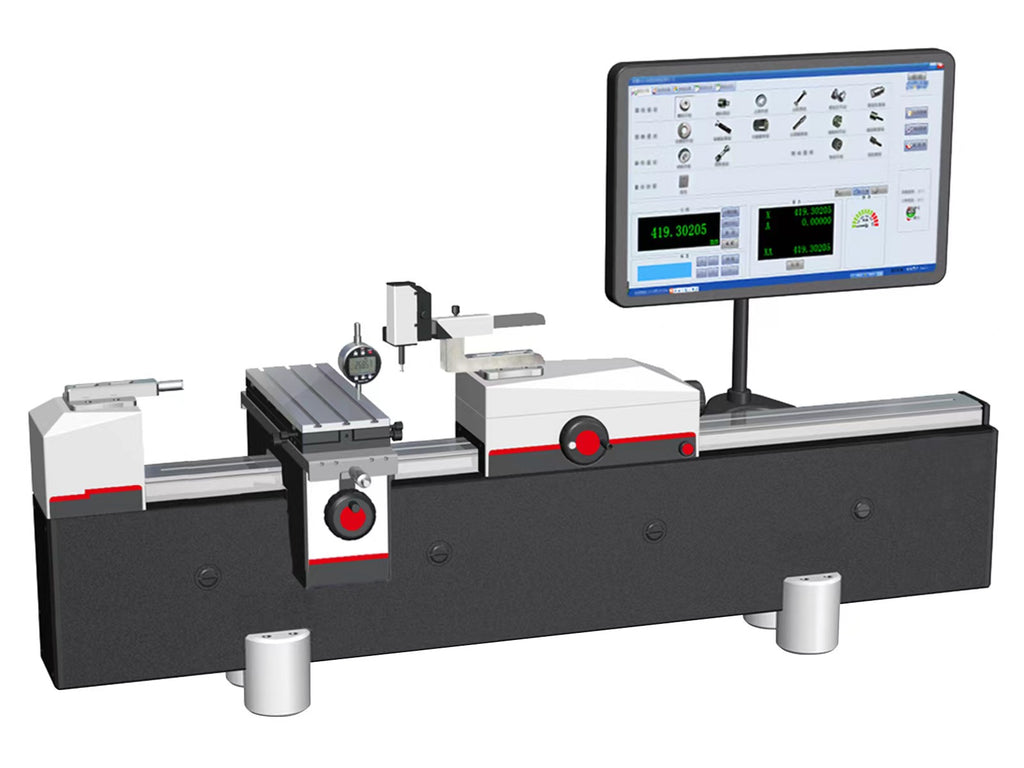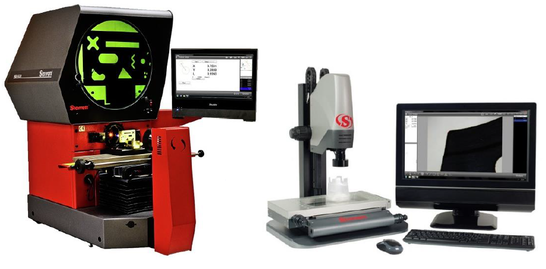5 perks of adopting optical measurement in high-precision manufacturing
5 perks of adopting optical measurement in high-precision manufacturing
Blog Article
Understanding Exactly How Optical Measurement Systems Enhance Quality Assurance Processes
When you're looking to boost high quality control procedures, comprehending optical dimension systems is essential. These innovations provide exact, non-contact dimensions that can transform your evaluation techniques. By leveraging innovative techniques, you can improve procedures and decrease mistakes. But how precisely do these systems integrate into existing process, and what benefits do they bring? Allow's discover the vital facets that make optical measurement a game-changer in quality management.

The Fundamentals of Optical Dimension Equipments
Optical dimension systems play a critical duty in assuring product quality across numerous sectors. These systems use light-based innovations to gather specific information regarding physical attributes, such as measurements, surface area finish, and color. By using lasers, electronic cameras, and sensing units, you can accomplish non-contact measurements that decrease the danger of damaging fragile products.
Recognizing the basics of these systems is fundamental for reliable quality assurance. They operate on principles like refraction, diffraction, and reflection, enabling you to evaluate numerous materials and forms. The accuracy and speed of optical dimensions allow real-time monitoring, which assists you identify flaws early in the production process.
Moreover, these systems can be integrated with software program for improved information evaluation, producing a thorough high quality management technique. By leveraging optical dimension systems, you not only boost efficiency yet also ensure your items meet rigid quality requirements, inevitably improving client satisfaction.
Types of Optical Dimension Technologies
Countless sorts of optical measurement modern technologies are available, each developed to satisfy details requirements in high quality control. You could run into laser triangulation, which gauges range by analyzing the angle of a reflected laser beam of light. This innovation is excellent for capturing precise dimensions in 3D area.
One more choice is structured light, where you forecast a series of light patterns onto a surface to produce a comprehensive 3D design. This approach functions well for intricate geometries.
After that there's interferometry, which can identify minute adjustments in surface area accounts by assessing the disturbance patterns of light waves. This is specifically valuable for applications calling for nanometer accuracy.
You might likewise think about optical coherence tomography, which offers high-resolution photos of internal features without harming the things. Each innovation serves different needs, so selecting the appropriate one is essential for attaining ideal top quality control outcomes.
Key Benefits of Optical Dimension in Top Quality Control
When it pertains to quality assurance, leveraging optical measurement modern technologies can greatly improve precision and performance. These systems permit you to catch comprehensive measurements promptly, minimizing the time required for assessments. You'll discover that optical dimensions can determine even the tiniest flaws that might go undetected with conventional methods, making certain product uniformity.
Furthermore, making use of optical measurement systems frequently brings about minimized waste and rework, as you catch concerns early in the production procedure. You'll also value the non-contact nature of numerous optical approaches, which lessens damage to delicate parts during analysis. This flexibility enables a more comprehensive series of applications throughout various materials.
With real-time information collection, you can make informed decisions quickly, streamlining your quality control processes (optical measurement). Ultimately, incorporating optical measurement into your top quality control strategy not only improves productivity however additionally enhances customer fulfillment by supplying higher-quality items consistently
Exactly How Optical Dimension Equipment Improve Accuracy and Precision
Optical measurement systems improve precision and accuracy by boosting dimension resolution, allowing you to discover even the tiniest variants. With real-time information evaluation, you can make prompt adjustments and decisions, ensuring your processes stay on track. This combination not only enhances product high quality however additionally simplifies your quality assurance efforts.
Enhanced Dimension Resolution
By leveraging innovative modern technologies, optical measurement systems significantly enhance dimension resolution, leading to improved accuracy and accuracy in high quality control. You'll notice a considerable difference in the clearness of dimensions, enabling you to recognize even the tiniest discrepancies from requirements. Eventually, boosted measurement resolution not just boosts product top quality but likewise maximizes resource use, ensuring that you satisfy consumer expectations constantly.
Real-Time Information Evaluation
Although standard dimension systems frequently rely upon postponed data handling, real-time information evaluation in optical dimension systems transforms the method you monitor quality. By supplying prompt feedback, these systems enable you to discover inconsistencies and incongruities as they occur, allowing for quick restorative activities. You'll experience better precision since you can promptly contrast measurements versus predefined criteria. This eliminates uncertainty and reduces the risk of problems slipping with. Furthermore, real-time information assists you collect beneficial understandings over time, fine-tuning your quality control processes. With this advanced innovation, you'll enhance both precision and efficiency, ensuring that your products consistently meet high criteria. Accept real-time analysis, and watch your quality control initiatives rise to brand-new heights.
Incorporating Optical Measurement Into Existing Quality Control Processes
Incorporating optical dimension into your existing top quality control processes can significantly enhance precision and effectiveness. By incorporating optical dimension systems, you can streamline information collection, decreasing human mistake while boosting the speed of assessments. Start by recognizing essential factors websites in your assembly line where optical dimensions will supply the most worth.
Next, train your group on the new innovation, guaranteeing they comprehend just how to utilize the systems properly. This training will aid them interpret results promptly and precisely.
You need to also develop a procedure for incorporating optical data into your existing top quality administration software application. This integration permits real-time analytics and coverage, boosting decision-making.
Consistently examine the information and comments from your team to recognize any kind of locations for renovation. With these steps, you'll not only enhance your quality assurance procedures yet likewise foster a society of continual renovation within your company.
Case Studies: Successful Application of Optical Dimension Solutions
In this area, you'll discover just how optical dimension systems have transformed quality assurance in markets like aerospace and vehicle production - optical measurement system. You'll see real-world instances of exactly how these modern technologies boosted precision and performance. These check my blog study highlight the tangible benefits of integrating optical systems into production procedures
Aerospace Sector Applications
As the aerospace sector encounters increasing demands for precision and effectiveness, business are turning to optical measurement systems to enhance their quality control processes. A leading aircraft maker integrated optical measurement innovation to examine turbine blades, decreasing assessment time by 50% while enhancing accuracy.
Automotive Manufacturing Success
Optical dimension systems have likewise made significant strides in the automobile manufacturing industry, where accuracy is crucial to lorry performance and safety. BMW incorporated optical dimension for body assembly, guaranteeing elements fit completely, which reduced rework and enhanced production efficiency. These instance research studies show just how optical measurement systems equip you to attain tighter tolerances, lessen waste, and elevate general item quality.
Future Patterns in Optical Dimension and High Quality Control
While developments in modern technology remain to improve the production landscape, the future of optical measurement and top quality control looks appealing - optical measurement. You'll see a considerable shift towards automation and AI assimilation, enabling systems to assess data in real-time. This indicates quicker decision-making and lowered human mistake, ultimately improving product high quality
In Addition, as 3D imaging technology enhances, you'll gain from more precise measurements of complicated geometries, making it much easier to keep limited resistances. The surge of cloud-based remedies will certainly additionally permit you to access data remotely, helping with partnership and enhancing procedures.
Furthermore, sustainability will certainly play a crucial function in future advancements. Expect optical measurement systems to focus on energy efficiency and waste decrease, lining up with international ecological goals. By embracing these trends, you can guarantee your quality assurance procedures continue to be sophisticated, aiding your company flourish in an increasingly affordable market.
Frequently Asked Inquiries
What Industries Advantage A Lot Of From Optical Measurement Systems?
You'll locate markets like manufacturing, aerospace, and auto advantage most from optical measurement systems. These sectors rely upon specific measurements for quality guarantee, making sure products fulfill rigid standards and enhancing general operational performance.
Exactly how Do I Choose the Right Optical Dimension System?
To select the right optical dimension system, evaluate your specific requirements, consider the sort of measurements you call for, assess the system's accuracy, and ensure it fits your spending plan and operational requirements.
What Are Usual Challenges in Applying Optical Measurement Equipments?
You'll deal with challenges like combination with existing systems, ensuring find more info precise calibration, educating staff properly, and handling prices. Identifying these difficulties early helps you establish approaches to overcome them and successfully implement optical dimension systems.

Exist Training Resources Available for Optical Dimension Technologies?
Yes, there're numerous training resources available for optical measurement technologies. You can discover on the internet training courses, webinars, and workshops supplied by sector specialists or companies. These sources can aid you effectively execute and use these sophisticated systems.
Exactly How Do Optical Measurement Solutions Compare to Conventional Measurement Methods?
Optical measurement systems offer greater precision and rate contrasted to typical approaches. They lower human mistake, allow non-contact dimensions, and offer real-time data analysis, making them extra reliable for numerous applications in quality assurance.
Final thought

Optical measurement systems increase accuracy and precision by improving dimension resolution, permitting you to detect even the smallest variations.By leveraging sophisticated innovations, optical dimension systems substantially boost dimension resolution, leading to boosted precision and accuracy in top quality control.Although traditional measurement systems frequently depend on postponed information handling, real-time information analysis in optical dimension systems changes the way you keep an eye on high quality.As the aerospace industry faces increasing demands for accuracy and performance, firms are transforming to optical dimension systems to improve their high quality control processes. How Do Optical Measurement Systems Contrast to Typical Dimension Techniques?
Report this page